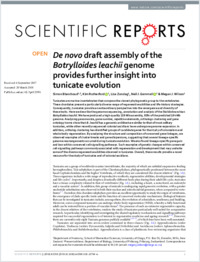De novo draft assembly of the Botrylloides leachii genome provides further insight into tunicate evolution
- Blanchoud, Simon Department of Anatomy, School of Biomedical Sciences, University of Otago, P.O. Box 56, Dunedin, 9054, New Zealand - Department of Biology, University of Fribourg, Switzerland
- Rutherford, Kim Department of Anatomy, School of Biomedical Sciences, University of Otago, P.O. Box 56, Dunedin, 9054, New Zealand
- Zondag, Lisa Department of Anatomy, School of Biomedical Sciences, University of Otago, P.O. Box 56, Dunedin, 9054, New Zealand
- Gemmell, Neil J. Department of Anatomy, School of Biomedical Sciences, University of Otago, P.O. Box 56, Dunedin, 9054, New Zealand
- Wilson, Megan J. Department of Anatomy, School of Biomedical Sciences, University of Otago, P.O. Box 56, Dunedin, 9054, New Zealand
-
03.04.2018
Published in:
- Scientific Reports. - 2018, vol. 8, no. 1, p. 5518
English
Tunicates are marine invertebrates that compose the closest phylogenetic group to the vertebrates. These chordates present a particularly diverse range of regenerative abilities and life-history strategies. Consequently, tunicates provide an extraordinary perspective into the emergence and diversity of these traits. Here we describe the genome sequencing, annotation and analysis of the Stolidobranchian Botrylloides leachii. We have produced a high-quality 159 Mb assembly, 82% of the predicted 194 Mb genome. Analysing genome size, gene number, repetitive elements, orthologs clustering and gene ontology terms show that B. leachii has a genomic architecture similar to that of most solitary tunicates, while other recently sequenced colonial ascidians have undergone genome expansion. In addition, ortholog clustering has identified groups of candidate genes for the study of colonialism and whole-body regeneration. By analysing the structure and composition of conserved gene linkages, we observed examples of cluster breaks and gene dispersions, suggesting that several lineage-specific genome rearrangements occurred during tunicate evolution. We also found lineage-specific gene gain and loss within conserved cell-signalling pathways. Such examples of genetic changes within conserved cell-signalling pathways commonly associated with regeneration and development that may underlie some of the diverse regenerative abilities observed in tunicates. Overall, these results provide a novel resource for the study of tunicates and of colonial ascidians.
- Faculty
- Faculté des sciences et de médecine
- Department
- Département de Biologie
- Language
-
- English
- Classification
- Biological sciences
- License
- License undefined
- Identifiers
-
- RERO DOC 309421
- DOI 10.1038/s41598-018-23749-w
- Persistent URL
- https://folia.unifr.ch/unifr/documents/306826
Statistics
Document views: 55
File downloads:
- bla_dnd.pdf: 142
